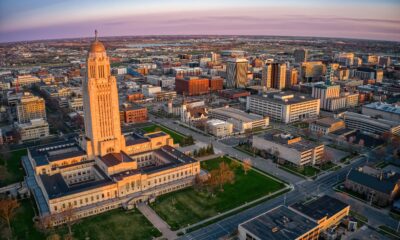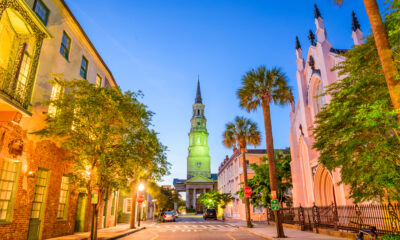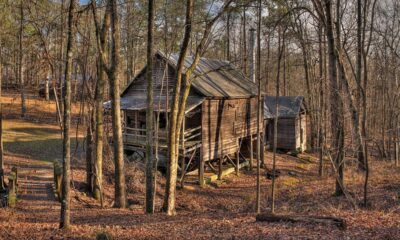Alaska
When six H-bombs threatened an ancient Alaskan village – and lost
Published
3 weeks agoon

The Iñupiat Victory Over Project Chariot’s Nuclear Harbor
In 1958, the U.S. Atomic Energy Commission had a wild plan: blow up six hydrogen bombs near Point Hope, Alaska to make a harbor. The Iñupiat people said no.
Their village had stood for 2,500 years, and they weren’t about to let nuclear bombs ruin their home. With help from scientists, they took on the most powerful agency in America and won.
Just 50 miles south at Cape Krusenstern, beach ridges tell an even longer story – 5,000 years of Iñupiat life through changing climates and cultures.
The fight against Project Chariot sparked a movement that changed Alaska Native rights forever.

First Iñupiat People Made Their Home 5,000 Years Ago
About 5,000 years ago, sea levels along Alaska’s northwest coast finally stopped changing after thousands of years. This let beach ridges form at Cape Krusenstern.
The Denbigh Flint people set up the first camps on these beaches. By 2,500 years ago, folks moved to Point Hope peninsula where they could hunt giant bowhead whales.
These early Arctic people came up with smart ways to live in one of Earth’s toughest places. Their settlements grew into the longest continuously lived-in place in North America.

Arctic Cultures Thrived Through Centuries of Change
The beach ridges at Cape Krusenstern tell a story of human survival.
As each new ridge formed, people moved their homes, leaving behind items from five major cultural periods: Denbigh, Choris, Ipiutak, Birnirk, and Thule.
The Ipiutak people at Point Hope (500 BC – 100 AD) made beautiful art and built Old Tigara village. Over thousands of years, these communities grew into complex whaling societies with clear social ranks and leaders.
The 114 beach ridges work like a timeline showing how people adjusted to changing seas and climate.

Outsiders Arrived But Iñupiat Ways Continued
European whalers first came to the Chukchi Sea in the 1850s, bringing new tools, materials, and sickness to the area.
The Kotzebue area became a center for Qatnut, old-time trading gatherings where Arctic peoples swapped goods and news.
A short gold rush in the 1890s brought many miners to the Seward Peninsula and Kotzebue Sound, creating short-lived boom towns.
Despite these newcomers, the Iñupiat people kept their hunting ways, social groups, and spiritual beliefs alive. Point Hope stayed much the same community it had been for over two thousand years.

Cold War Dreams Led to Nuclear Nightmares
The U.S. government started Operation Plowshare in 1957, hoping to find “peaceful” uses for nuclear bombs.
A year later, physicist Edward Teller suggested Project Chariot, a plan to set off six hydrogen bombs at Cape Thompson to make an artificial harbor.
The bombs would equal about 160 Hiroshima explosions, and the site was just 30 miles from Point Hope.
The Atomic Energy Commission (AEC) said the harbor would help Alaska’s economy by making it easier to ship coal and other resources.
They sold the idea to Alaska’s business leaders but left out the people who actually lived there.

Village Elders Learned the Truth About Nuclear Plans
The AEC kept Point Hope folks in the dark about Project Chariot at first. Talk about planned nuclear blasts spread through native communities, causing worry.
In spring 1959, a visiting missionary told people the rumors were true during a community meeting in Point Hope.
Village elders quickly understood that the blasts would poison their hunting grounds with radioactive fallout. The caribou, whales, seals, and fish they needed for food would become unsafe to eat.
The Iñupiat people knew about health risks from following news about radiation sickness from nuclear testing in the Pacific.

Scientists Stood Up Against Government Pressure
The University of Alaska took $107,000 from the AEC in 1959 to study Project Chariot’s impacts on the land. The findings worried many researchers.
Biologist Les Viereck quit in 1961 when the AEC tried to hide radiation risks in their reports. He lost his teaching job for speaking up.
Professor William Pruitt got fired in 1962 for refusing to change his findings and for openly criticizing the project. The scientists found that Arctic food chains could easily pick up radioactive stuff.
Tests showed caribou already had seven times more strontium-90 than regular cattle from Soviet nuclear tests thousands of miles away.

Small Village Took On the U.S. Government
The Point Hope Village Council fought against the nuclear plan, showing great courage by standing up to the federal government.
In 1960, the AEC held a town meeting where Iñupiat leaders flatly rejected all safety claims.
The next year, the Village Council wrote directly to President Kennedy, slamming Project Chariot and asking him to stop it. Residents pointed to the Bikini Atoll disaster, where Pacific Islanders got very sick after U.S. nuclear tests.
Their grassroots fight caught the eye of groups like the Sierra Club and Wilderness Society, who joined the battle against the AEC’s plans.

Environmental Studies Revealed Serious Problems
The AEC pushed Project Chariot back from 1960 to 1962, hoping studies would prove the plan was safe. This plan backfired.
The research confirmed serious health risks and showed how radioactive fallout would move through the food chain.
Scientists pointed out that the planned harbor would freeze solid nine months each year, making it mostly useless for shipping.
Newspapers and magazines across the country ran the story, turning public opinion against the nuclear digging plan. The AEC found itself fighting a losing battle against both science and growing public anger.

Government Secretly Brought Radioactive Materials Anyway
The AEC officially canceled Project Chariot in August 1962, citing public pushback and lack of economic benefit.
But that same month, they secretly shipped radioactive soil from Nevada nuclear test sites to Cape Thompson. Scientists used this dirty soil to study how radioactive materials would move through the Arctic environment.
When the experiments finished, workers buried the waste in a shallow mound without any markers or warning signs.
The government kept this contamination completely secret from the Iñupiat people for thirty years, never warning them about risks from hunting or gathering food in the area.

Truth About Contamination Finally Came to Light
University of Alaska researcher Dan O’Neill found papers about the secret radioactive waste in old government files during the 1990s.
State officials tested the burial site and found radioactive material still there just two feet underground.
Point Hope residents had suffered unusually high cancer rates for decades, raising questions about possible links to the contamination.
Village leaders demanded cleanup and full disclosure of everything left behind at Cape Thompson.
The federal government started an investigation and began efforts to remove the radioactive soil, though many felt these actions came far too late.

Iñupiat People Preserved Their Way of Life
The fight against Project Chariot sparked a new era of Native political activism that led directly to the Alaska Native Claims Settlement Act of 1971, which recognized indigenous land rights.
Point Hope community members successfully moved their village to higher ground in the mid-1970s when coastal erosion threatened their homes.
Cape Krusenstern became a National Monument in 1978, protecting the archaeological evidence of 5,000 years of continuous human habitation.
The Iñupiat people continue their traditional subsistence practices today while advocating for environmental protection.
Their story shows both remarkable resilience through millennia of environmental change and successful resistance against powerful government interests that threatened their homeland.

Visiting Cape Krusenstern National Monument, Alaska
You can visit Cape Krusenstern National Monument for free, but you’ll need to fly by charter air taxi from Kotzebue since there are no roads or facilities. Get to Kotzebue by commercial jet from Anchorage first.
The monument stays open year-round despite winter temperatures hitting -50°F.
Stop by the Northwest Arctic Heritage Center at 171 3rd Avenue in Kotzebue to learn about the Iñupiat people’s fight against Project Chariot and their 5,000-year history.
This article was created with AI assistance and human editing.
Read more from this brand:
John Ghost is a professional writer and SEO director. He graduated from Arizona State University with a BA in English (Writing, Rhetorics, and Literacies). As he prepares for graduate school to become an English professor, he writes weird fiction, plays his guitars, and enjoys spending time with his wife and daughters. He lives in the Valley of the Sun. Learn more about John on Muck Rack.


Here Are 12 Things People from West Virginia Do That Seem Insane To Everyone Else

Here Are 12 Things People from Washington Do That Seem Insane To Everyone Else

Here Are 12 Things People from Virginia Do That Seem Insane To Everyone Else

New Mexico Albuquerque International Balloon Fiesta wrap-ups and fall arts

Mississippi Natchez Trace fall festivals and music events

12 Reasons Why You Should Never Ever Move to Florida

Best national parks for a quiet September visit

In 1907, Congress forced Roosevelt to put God back on U.S. coins. Here’s why.

The radioactive secret White Sands kept from New Mexicans for 30 years

America’s most famous railroad photo erased 12,000 Chinese workers from history
Trending Posts

 Pennsylvania3 days ago
Pennsylvania3 days agoHere Are 12 Things People from Pennsylvania Do That Seem Insane To Everyone Else

 North Carolina4 days ago
North Carolina4 days agoHere Are 12 Things People from North Carolina Do That Seem Insane To Everyone Else

 Nebraska6 days ago
Nebraska6 days agoHere Are 12 Things People from Nebraska Do That Seem Insane To Everyone Else

 Maine5 days ago
Maine5 days agoThe ruins of a town that time forgot are resting in this Maine state park

 New York4 days ago
New York4 days agoHere Are 12 Things People from New York Do That Seem Insane To Everyone Else

 South Carolina2 days ago
South Carolina2 days agoHere Are 12 Things People from South Carolina Do That Seem Insane To Everyone Else

 Ohio4 days ago
Ohio4 days agoHere Are 12 Things People from Ohio Do That Seem Insane To Everyone Else

 Georgia5 days ago
Georgia5 days agoThis plantation’s slave quarters tell Georgia’s slowest freedom story
